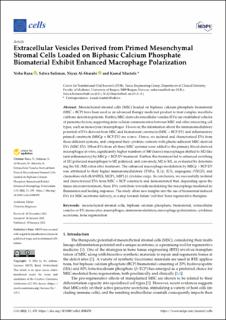| dc.description.abstract | Mesenchymal stromal cells (MSC) loaded on biphasic calcium phosphate biomaterial (MSC + BCP) have been used as an advanced therapy medicinal product to treat complex maxillofacial bone defects in patients. Further, MSC-derived extracellular vesicles (EVs) are established vehicles of paracrine factors, supporting inter-cellular communication between MSC and other interacting cell types, such as monocytes/macrophages. However, the information about the immunomodulatory potential of EVs derived from MSC and biomaterial constructs (MSC + BCP:EV) and inflammatory primed constructs (MSCp + BCP:EV) are scarce. Hence, we isolated and characterized EVs from these different systems, and compared their cytokine contents with plastic-adherent MSC-derived EVs (MSC:EV). When EVs from all three MSC systems were added to the primary blood-derived macrophages in vitro, significantly higher numbers of M0 (naive) macrophages shifted to M2-like (anti-inflammatory) by MSCp + BCP:EV treatment. Further, this treatment led to enhanced switching of M1 polarized macrophages to M2 polarized, and conversely, M2 to M1, as evaluated by determining the M1/M2 ratios after treatment. The enhanced macrophage modulation by MSCp + BCP:EV was attributed to their higher immunomodulatory (TNFα, IL1β, IL5), angiogenic (VEGF), and chemokine-rich (RANTES, MCP1, MIP1β) cytokine cargo. In conclusion, we successfully isolated and characterized EVs from MSC + BCP constructs and demonstrated that, depending upon the tissue microenvironment, these EVs contribute towards modulating the macrophage-mediated inflammation and healing responses. The study offers new insights into the use of biomaterial-induced EVs for MSC secretome delivery, as a step towards future ‘cell-free’ bone regenerative therapies. | en_US |

